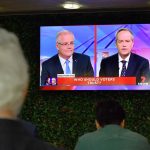Australia – a new federation, a new republic, a new hope

Is it time to abolish the States? The political and constitutional barriers are large. David Thorp offers an alternative vision for Australia that he thinks could inspire the majority of voters.
Australia is facing the prospect of a plebiscite or referendum on same-sex marriage, at great expense, which supporters of the cause – the majority of the population – oppose because of its divisive nature, and a minority see as a means of thwarting change.
We seem to have lost the plot! A referendum should be a rallying call for a vision that unites the overwhelming majority of Australians, and regardless of its undoubtable merits, same-sex marriage is an issue focussed on minorities, which fails to achieve that.
The same goes for the recently failed New Zealand flag referendum. The proposed new flag was a great design (in my opinion), but that’s all it was. A flag alone wasn’t enough to motivate a majority for change. Likewise for Australian’s failed 1999 republic referendum – despite the generally favourable support for the idea, in the end it was a vote to get rid of something (the Queen), not a substantive positive vision for something worth taking a risk for.
Yet as Klaas Woldring argues in his article advocating a multi-question plebiscite, there are so many other major, worthy issues that could be put to the people – not least the reform of an outdated Australian federation – that in combination (potentially including same-sex marriage) could constitute a compelling, optimistic vision for change and hope for the future.
What might the components of such a vision be? Most obviously, we could hardly change the constitution to recognise the rights of minorities with different sexual orientations, but fail to recognise the original Aboriginal inhabitants of this land (especially as that issue is also already being promoted for constitutional recognition).
And if we’re going to develop a modern constitution that talks about individual rights, then there’s a strong argument for also recognising the civil liberties of the majority, which are increasingly being seen as compromised by a variety of new laws, from various “nanny state” measures to more significant erosion of freedoms in the name of law and order/counter-terrorism, including the detention and questioning in NSW of anyone over the age of 14 for two weeks without charge.
OK, so much for high principles, but what about the bread-and-butter issues that really motivate the punters? Well, this is where reform of the federation really comes in – health, education, services for vulnerable/disabled families and children, transport, energy and environment, and the growing fiscal cost arising from an ageing population.
If there’s one thing that unites Australians in politics, it’s a frustration with the “blame game” played by State and federal politicians over these core issues of public service. Current split responsibilities mean bureaucracy and buck-passing clouds accountability and obstructs positive reform progress. Plus, with a relatively small population and multiple levels of government Australia is simply over-governed: there’s just not enough talented politicians to fill the excessive number of places available (basic supply and demand economics).
Recently the Prime Minister proposed to address these issues, and the related problem of “vertical fiscal imbalance” (the mismatch between accountability for spending by the States and revenue-raising by the Commonwealth), by giving States the power to vary and get a share of income tax, in order to fund growing cost pressures in hospitals and education. But that proposal quickly died, because it seems the States don’t actually want to be accountable for how much they spend.
It’s hardly surprising that many despairing Australians think it’s time to abolish the States. But the political and constitutional barriers to this are large. So is there another way?
Good news – yes! In all core public services there are currently either plans afoot or overwhelming pressures that point in the right direction:
Health and vulnerable family-support services:
- The Commonwealth is currently establishing Primary Health Networks (PHNs), which although limited in scope at present, have the potential to play a dominant role optimising the funding and coordinated collaboration of flexible, person-centred “social purpose” services across the entire scope of GPs, hospitals and early-intervention/preventative family-support services such as child welfare, DFV and social housing.
- Commonwealth-funded, competitive PHNs that are chosen by end-customers could drive greater customer-focus, efficiencies and service effectiveness in a sector that is otherwise forecast to place significant future pressures on government budgets. (Commonwealth funding could also be a useful bribe to get States to agree to these changes in responsibilities!)
Education:
- With ever-increasing funding for schools failing to arrest an alarming decline in Australia’s world ranking in test results, there’s a growing need to consider governance changes that can promote quality teaching – which is the overwhelming factor determining student outcomes. Similar models of network “coopetition” to PHNs for health/family services could be the answer, for example through competing networks providing “teaching leadership” services to those schools that choose them via elected school boards.
Justice:
- Surely if we are to be one nation, then all Australians should have the same basic rights under law? And likewise, all Australian corporations and other organisations should be expected to abide by the same ethical and legal standards.
- A referendum could establish a “bill of rights” that protected the individual liberties of all minorities and the majority – enshrining Aussie values of equality and a “fair go” for all genders, ethnic origin and sexual orientation.
- A consistent, equitable national justice and police system, with a single national industry corruption regulator (supported by 80% of voters) could also address current issues in relation to the Australian Building and Corruption Regulator and NSW ICAC. It could also be a great opportunity to deliver a more efficient reformed court system, which currently is incapable of delivering timely and affordable justice and in some cases actively destroys the lives of vulnerable families and children, especially in Aboriginal communities.
Transport and urban planning:
- In Sydney, recent council amalgamations and the newly-established Greater Sydney Commission (GSC) should facilitate better strategic planning linked to community views. Although currently unelected, the GSC is expected to adopt increased “community participation” through “further reforms to come”, which could diminish the need for any State government role.
- In other major States, Melbourne already has a similar Metropolitan Planning Authority, Brisbane already has a single council, and although Perth abandoned council amalgamations, this could be reconsidered.
Energy and environment:
- We already have a national, competitive energy market, which (at least in theory) is responsive to individual consumer needs, and we will soon have to face reality and establish a national emissions trading scheme.
- The recent decision by a Labor Queensland Government to approve the Carmichael coal mine at the expense of the Great Barrier Reef indicates the need for national environmental regulation (as well as revealing Queensland’s financial problems). It is not their Barrier Reef to destroy! It belongs to everyone.
Is there anything left to justify the existence of the States? Well yes; it doesn’t matter much to me, but it does for a lot of Australians – sport! The States can remain as historic boundaries that support continued friendly sporting rivalry and the management of related facilities and programs, as well as other cultural and non-core community services that remain outside the role of the Commonwealth. It would then be up to each State to choose how much they rationalise their bureaucracies in accordance with their reduced responsibilities. Queensland for example, which already has relatively few, large councils and only one house of parliament, could choose to make little in the way of further changes.
I think this is a vision that could inspire the majority of voters. A positive vision, not based on rejecting our UK heritage, but for a multicultural republic based on a “fair go for all”. Now that would be worth creating a republic [1] and new flag for!
On which, below is my proposed flag design, developed from the 1993 competition-winning design, with a yellow and green border added to match the national sporting colours and to symbolise Australia’s sandy beaches and green coastline. The red Uluru sits in the desert inner, with a golden sunrise layer above it to symbolise a new dawn for Australia, and Aboriginals especially. A black Uluru shadow (which also makes Uluru look a bit like a boomerang) further strengthens the Aboriginal link. Some alternative flag designs and further thoughts on reforming Australia, including real-time electoral representation, are on my website here.

[1] But a republic needn’t mean electing a President with substantive powers, which I think would only lead to new buck-passing.

Dr David Thorp is an analytical, strategic reformer who works in the field of public service strategy. His interests include finance, economics, transport, housing, sustainable energy and social services.











